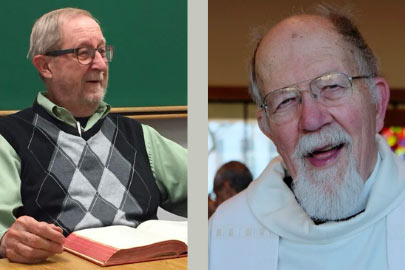Alum reflects on the legacy of professors Klein and Krentz

In J.R.R. Tolkien’s Lord of the Rings: The Two Towers, Hobbits Merry and Pippin, confused and a bit lost at having been separated from their party, find themselves in Fangorn Forest. There, these diminutive Hobbits (a bit under 5 feet, by Tolkien’s measure) are addressed by a 14-foot giant of a tree, Treebeard, an Ent. The scene turns out to be a tender one, despite the size differential between the creatures. The Ents are ancient, wise, speak a different language, and turn out to be quite kind despite their enormous stature.
The Ents save Merry and Pippin.
And while they would probably brush off any suggested comparison to these wise giants, Professor Klein and Professor Krentz (never would I address either by their first names, despite their invitation postgraduation) were, at least for me, akin to these mythic beings. They were ancient, wise, spoke another language, and were quite kind. Channeling their kindness and knowledge has saved me more than once in my life. I remember taking my seat in Old Testament that first year at LSTC and thinking, “I recognize this professor’s name…” but couldn’t quite place it until I pulled out my HarperCollins Study Bible (Revised Edition) to find that Dr. Klein had, quite literally, written the book about the book in hand (1 and 2 Chronicles notes).
Once on a Hebrew exam I had misidentified a word. “Dr. Klein,” I said, “I think I got this one correct. It’s ‘horse,’ right?” “Ah,” he said, “it’s actually ‘mare.’ Note the feminine form.” I smiled and then laughed, “Dr. Klein, I don’t think I even knew a female horse was called a mare, can’t you cut me a break?” “No,” he responded, “but it looks like you learned two new things today.”
Wisdom over grades. Gentle discipline. A respect for the work. I carry this with me.
Similarly, as I took a prospective student to sit in on Dr. Krentz’s New Testament course, arriving just a bit late, I informed (warned?) the student that Dr. Krentz had written the authoritative commentary on 1 Thessalonians. “What does that mean?” the student asked. “It means,” I said with a smirk, “that he’s forgotten more Greek than we’ll ever know.” As we slipped into the class, Dr. Krentz was reading out loud from his Greek New Testament, briefcase with the “Seminex” bumper sticker sitting at his side.
He glanced up as we walked in, I nodded, and he continued reading straight from the Greek without missing a beat, translating on the fly. He would expect us to eventually do the same.
Drs. Klein and Krentz were premier intellectuals, but they were also robust theological activists. Having lived through the trauma of Seminex, they brought with them an advocacy for women in the pulpit, for queer students in the collar, for those on the margins to be moved into the middle.
Their lived experience helped them to help others. We students who, though we may have been intimidated by their presence and felt like we paled in comparison to their long, distinguished shadows, were invited to think critically, laugh heartily at their jokes, and mine the depths of the faith before us using their headlamps as guides.
Often students will describe learning from honored teachers using that ancient Socratic image of “sitting at their feet.” I’ve used this image in describing my time with Dr. Klein, Dr. Krentz and many others from those seminary years. But I think they’d probably offer a different interpretation. I think they’d say we sat alongside them at the foot of the faith, at the feet of the crucified and risen one, learning and growing together, by God.
And that humility is what I will remember and cherish most about these wise, kind giants who, as unsure students who were often a bit lost wandered into their classroom, found a safe place to live and learn about the ancient but very alive faith they embodied.
Original article published in the Winter/Spring 2022 Epistle Magazine; written by alum Tim Brown